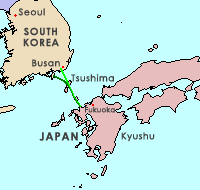Japan-Korea tunnel
The Japan-Korea Tunnel ( Japanese 日韓 ト ン ネ ル , Nikkan tonneru , also: Korea-Japan-Tunnel , Korean Hangeul : 한일 해저 터널 , Han-Il haejeo teoneol ) is a proposed tunnel between Japan and South Korea , which is located under the Korea Strait would run along the islands of Iki and Tsushima . The shortest proposed route is approximately 128 km, more than twice as long as the Gotthard Base Tunnel , which at 57 km is currently the longest railway tunnel in the world.
The first proposal for this connection was made in 1917, followed by concrete plans in the early 1940s, which were abandoned after the Second World War. At the beginning of 2008 the proposal was brought up again. An economic and technical feasibility study for the tunnel was commissioned in 2009 by South Korean President Lee Myung-bak .
In connection with the tunnel project, there are also efforts to open up North Korea to goods in transit. South Korea, and if the tunnel is built, Japan too, could be connected to the Eurasian rail network, which would provide an alternative means of transport to European sales markets for exported goods from Japan. Such considerations play an important role for the profitability to be forecast and thus the willingness to finance the tunnel project.
See also
- Sakhalin-Hokkaidō Tunnel - alternative proposal for a tunnel between Hokkaidō and the Russian Sakhalin
